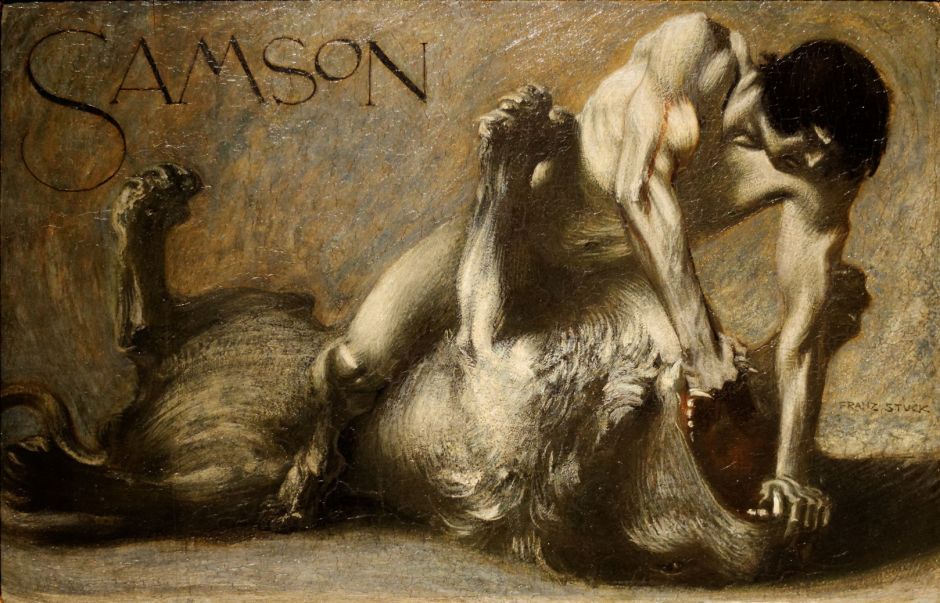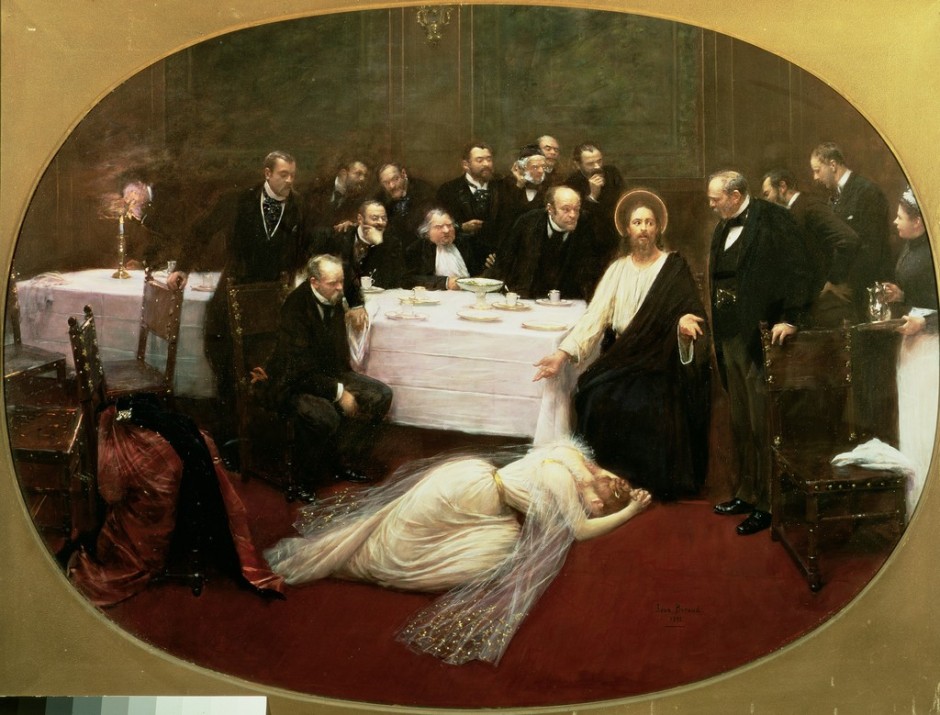Hair and its cutting have developed many associations across different cultures, the most consistent being with strength and life itself. Traditions of giving a loved one a lock of your hair as a keepsake are currently out of vogue in western society, but have been commonplace in the past. At one time, Egyptians used to stop cutting their hair when they travelled, and didn’t resume until they had returned home safely.
In this pair of articles, completing tomorrow, I look at paintings in which head rather than facial or body hair plays an important role. Today I consider the role of hair and its cutting in Christian religious narrative, of which the salient example is the story of the Israelite ‘judge’ Samson in the Old Testament. He was famed for the strength given him by God, which depended on him not cutting his hair.
When Samson was young, he fell in love with a Philistine woman. Despite the objections of his parents, he decided to marry her, and travelled to propose to her. On that journey, he was attacked by a lion, which he wrestled with and tore apart, thanks to his strength. He told no one about that episode, and when he was on his way to his wedding, came across the carcass of that lion, then containing a bees’ nest with honey. This inspired the line ‘out of strength came forth sweetness’, long used as a motto on tins of golden syrup.
During Samson’s wedding feast, he posed his thirty Philistine groomsmen a riddle based on his encounters with that lion:
Out of the eater came something to eat.
Out of the strong came something sweet.
The groomsmen didn’t guess the answer, which Samson only revealed after they had threatened him, and his bride had begged him to do so.

Léon Bonnat’s later career was dominated by teaching and painting portraits, but in 1891 he reaffirmed his brilliance at painting figures in Samson’s Youth.

Franz von Stuck’s Samson, curiously painted in the same year, shows the same scene.
Neither artist, though, depicted Samson’s hair as being long, key to the most widely painted story about him. Samson went on to give the Philistines a hard time. They approached Delilah and paid her to act as a temptress, to reveal the secret of his strength, to help them to attack it and weaken him. Delilah discovered that cutting Samson’s hair would render him weak, so did that, enabling the Philistines to overpower him, blind him, and fetter him in prison.

Peter Paul Rubens’ Samson and Delilah (c 1609-10) shows a man cutting the Israelite’s hair while he’s asleep on Delilah’s lap.

William Blake’s Samson Subdued was one of the large series of biblical watercolours he painted for Thomas Butts in around 1800-03. It shows the naked figure of Delilah holding a pair of scissors in her left hand, having apparently cut Samson’s hair off with them, and destroyed his prodigious strength. The biblical reference for this, written at the foot, is to Judges, chapter 16 verses 15-20:
And she said unto him, “How canst thou say, I love thee, when thine heart is not with me? thou hast mocked me these three times, and hast not told me wherein thy great strength lieth.” And it came to pass, when she pressed him daily with her words, and urged him, so that his soul was vexed unto death; That he told her all his heart, and said unto her, “There hath not come a razor upon mine head; for I have been a Nazarite unto God from my mother’s womb: if I be shaven, then my strength will go from me, and I shall become weak, and be like any other man.”
And when Delilah saw that he had told her all his heart, she sent and called for the lords of the Philistines, saying, “Come up this once, for he hath shewed me all his heart.” Then the lords of the Philistines came up unto her, and brought money in their hand. And she made him sleep upon her knees; and she called for a man, and she caused him to shave off the seven locks of his head; and she began to afflict him, and his strength went from him. And she said, “The Philistines be upon thee, Samson.” And he awoke out of his sleep, and said, “I will go out as at other times before, and shake myself.” And he wist not that the Lord was departed from him.
Although it’s clear from the text that it was “a man” who removed Samson’s hair, Blake follows the popular convention which makes for a stronger narrative painting.

A century later, Lovis Corinth painted several scenes from this story, starting in 1893. The Capture of Samson from 1907 shows the chaotic brawl resulting in Samson’s bondage. Corinth places himself in the left foreground, as one of Samson’s captors, and a naked Delilah kneels at the top centre.

Rembrandt’s Blinding of Samson from 1636 is an explicit depiction of the destruction of his eyes, as Delilah makes off behind with his hair and a pair of shears.

William Etty chose an unusual scene for his undated painting of Delilah before the Blinded Samson: Delilah, dressed in regal but excessive clothing with her hair wrapped in pearls and jewels, has come to visit the blind Samson in prison where he is in chains, outdoors rather than in a cell. Delilah appears to be trying to make her peace with him, but Samson struggles against his chains and is not going to be tempted by her again.

Lovis Corinth returned to Samson in this remarkable painting, his first major work after a stroke at the end of 1911, The Blinded Samson (1912). This expresses his feelings about his own battle against the sequelae of his stroke.
In the Samson story, it shows the once-mighty man reduced to a feeble prisoner, forced to grope his way around. No doubt Corinth didn’t intend to refer to its conclusion: with the aid of God, Samson pulled down the two central columns of the Philistines’ temple to Dagon, and brought the whole building down on top of its occupants.
The Old Testament also contains the story of the death of Absalom, son of King David, whose hair became caught in an oak tree, allowing his enemies to kill him. That has very seldom been painted, though. More popular are depictions of two stories conflated and attributed to the compound and largely apocryphal figure of Mary Magdalene, whose long tresses appear in two different contexts.

Titian painted a whole series of related portraits of the Penitent Magdalene. This is one of the earlier versions, commissioned for Vittoria Colonna through Federico II Gonzaga, the Duke of Mantua and son of Isabella d’Este, and painted in 1531. It’s innovative and to the modern eye quite erotic, at a time when paintings of Mary Magdalene were without exception prim and proper. Her hair and its use to partly cover her body is eyecatching.
This composite Mary was a beautiful but sinful young woman who revelled in sexual pleasure. She became a follower of Christ on her repentance, and after his crucifixion became a penitent widow. Even more unbelievable extensions to her story take her to Provence, in the south of France, where she baptised pagans in Marseilles and spent thirty years as a hermit in a cave near Sainte-Baume. She was thus the model of a sinful woman who was redeemed through faith in Christ. Her sin was common to all women, that of weakness of the flesh, and she became a powerful figure in the minds of many women in the Renaissance and later.

William Blake’s Mary Magdalene Washing Christ’s Feet is another of the biblical series for Thomas Butts painted in about 1803-05. It shows the scene during the supper at the house of Martha and Mary, which prefigured the Last Supper in several ways. This is told in the gospel of John, chapter 12 verses 1-8:
Then Jesus six days before the passover came to Bethany, where Lazarus was, which had been dead, whom he raised from the dead. There they made him a supper; and Martha served: but Lazarus was one of them that sat at the table with him. Then took Mary a pound of ointment of spikenard, very costly, and anointed the feet of Jesus, and wiped his feet with her hair: and the house was filled with the odour of the ointment.
Then saith one of his disciples, Judas Iscariot, Simon’s son, which should betray him, “Why was not this ointment sold for three hundred pence, and given to the poor?” This he said, not that he cared for the poor; but because he was a thief, and had the bag, and bare what was put therein. Then said Jesus, “Let her alone: against the day of my burying hath she kept this. For the poor always ye have with you; but me ye have not always.”
Presumably the man sat in the centre, wearing blue, is intended to be Lazarus; Mary and Jesus look awkward together: it has been proposed that this results from meanings which Blake attached to left and right, but here it is almost inevitable given the composition. This does, though, provide a full view of the curved and compacted figure of Mary, and her wiping of Jesus’ feet using her luxuriant and curly hair.

Mary Magdalene in the House of Simon the Pharisee (1891) is one of Jean Béraud’s more extraordinary paintings, and proved highly controversial at the time. The painting (and its title) refers to a story from the ministry of Jesus Christ, in which Jesus was invited to dine with a Pharisee. A woman who had lived a sinful life, usually assumed to have been Mary Magdalene, came, wet Jesus’ feet with her tears, and dried them with her hair before anointing them with perfume.
Christ and Mary Magdalene have been transplanted into a dinner attended instead by many prominent figures in the arts of the day. Among those identified are Hippolyte Taine (1828-1893), Eugène Chevreul (1786-1889), Alexandre Dumas the younger (1824-1895), Dr Adrien Proust (1834-1903), and Béraud himself.

